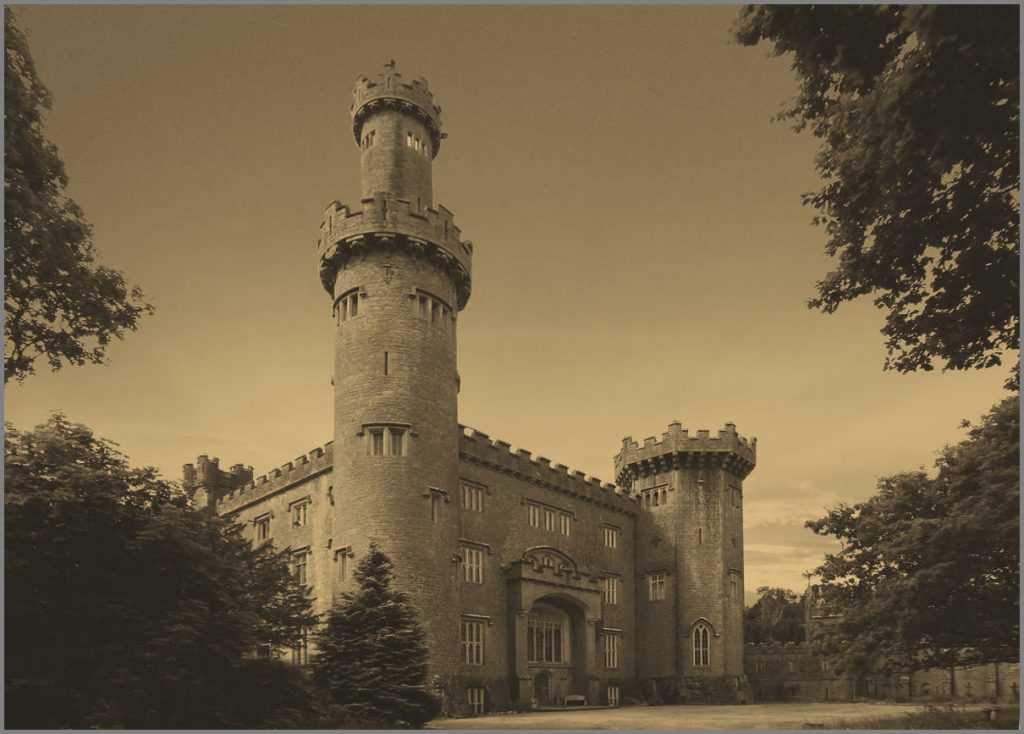A Gothic Masterpiece in County Offaly
Charleville Castle, located just outside the town of Tullamore in County Offaly, Ireland, is a striking example of Gothic Revival architecture. With its soaring towers, intricate stonework, and atmospheric setting in the heart of Ireland, the castle has captivated visitors for centuries. Beyond its architectural beauty, Charleville Castle holds a fascinating and often turbulent history, intertwined with tales of tragedy, aristocracy, and the supernatural.
Origins and Construction
Charleville Castle was commissioned in 1798 by Charles William Bury, the first Earl of Charleville, on the lands of an ancient oak forest. Designed by the renowned architect Francis Johnston, who also designed Dublin’s General Post Office, Charleville Castle is considered one of the finest examples of Gothic Revival architecture in Ireland. Johnston’s design was intended to convey power and prestige, incorporating medieval-style turrets, towers, and imposing stone facades that reflect the romanticism of the Gothic Revival period.
The construction of Charleville Castle was a statement of wealth and status. The Bury family, with their aristocratic connections, sought to create a residence that would stand as a testament to their influence. The castle took nearly 14 years to complete, with work finishing around 1812. Its grand halls, intricately decorated ceilings, and imposing staircases make it a true architectural gem of its time.
The Bury Family and Charleville’s Aristocratic Era
The Bury family occupied Charleville Castle for several generations, during which time the estate became known for its opulence and the family’s strong political and social connections. The Earls of Charleville played significant roles in Irish and British politics, often hosting lavish parties and gatherings in the castle’s grand ballroom and drawing rooms.
One of the most famous inhabitants of Charleville Castle was Charles William Bury’s granddaughter, Lady Harriet Bury. An adventurous and scholarly figure, Lady Harriet traveled widely and was involved in literary and intellectual circles in both Ireland and Britain. Her presence helped solidify the castle’s reputation as a center of culture and learning, further elevating its status in Irish society.
However, despite the splendor of the castle, the Bury family’s time at Charleville was not without tragedy. In 1861, the young daughter of the third Earl of Charleville, Harriet Bury, died in a tragic accident at the age of eight. According to local lore, she fell from the main staircase of the castle while playing. This heartbreaking event would later contribute to the castle’s reputation as one of Ireland’s most haunted locations.
Architectural Significance
Charleville Castle’s architectural style is emblematic of the Gothic Revival movement, which sought to reintroduce elements of medieval architecture into 18th and 19th-century designs. The exterior of the castle features characteristic Gothic elements such as pointed arches, ornate stone carvings, and battlements, all contributing to its imposing and romantic appearance.
Inside, the castle is equally impressive. The grand ballroom, with its high ceilings and decorative moldings, was designed for large gatherings and social events. The main staircase, an iconic feature of the castle, winds dramatically upwards and is adorned with hand-carved woodwork. It is this staircase where the tragic accident involving young Harriet Bury is said to have occurred, adding to its eerie allure.
Despite its grandeur, Charleville Castle was built during a time of political unrest in Ireland. The castle’s construction coincided with the Irish Rebellion of 1798, a period marked by conflict between Irish rebels and British forces. Though the castle itself was spared from violence, its construction reflects the complex relationship between Ireland’s aristocracy and the political turmoil of the time.
Paranormal Activity and the Castle’s Haunted Reputation
Charleville Castle has earned a reputation as one of Ireland’s most haunted places, drawing paranormal investigators and curious visitors alike. The most famous ghost associated with the castle is that of young Harriet Bury. It is said that her spirit still roams the halls, particularly near the grand staircase where she met her tragic end. Numerous reports of eerie occurrences, such as the sounds of a child’s laughter or unexplained cold spots, have contributed to the castle’s haunted reputation.
In addition to Harriet’s ghost, other supernatural sightings have been reported over the years. Visitors and staff have described hearing footsteps in empty corridors, seeing shadowy figures, and experiencing sudden drops in temperature. The paranormal activity has attracted the attention of international paranormal investigation teams, including those from popular television shows such as Ghost Hunters and Most Haunted.
Despite its haunted reputation, Charleville Castle remains a popular destination for those intrigued by both its historical and paranormal significance. The combination of its architectural grandeur and its eerie atmosphere creates a unique experience for visitors, whether they come for the history, the architecture, or the ghost stories.
Restoration and Modern Use
By the 20th century, Charleville Castle had fallen into disrepair. The Bury family had moved out, and the once-grand estate was left neglected for several decades. Fortunately, in the 1970s, restoration efforts began to bring the castle back to its former glory. Volunteers and preservationists took on the challenge of restoring the crumbling structure, and over the years, significant progress has been made in preserving the castle for future generations.
Today, Charleville Castle is used as both a tourist attraction and a venue for cultural events, including music festivals, art exhibitions, and historical tours. The castle’s atmospheric setting and well-preserved interiors make it a popular location for filmmakers and photographers as well. It has appeared in various documentaries, films, and television programs, further cementing its status as an iconic Irish landmark.
Conclusion
Charleville Castle stands as a remarkable testament to Ireland’s Gothic Revival architecture, aristocratic history, and enduring folklore. From its origins as a symbol of power and prestige to its current status as a cultural landmark and haunted attraction, Charleville Castle continues to capture the imagination of all who visit. Its fascinating blend of history, tragedy, and the supernatural makes it a unique and enduring part of Ireland’s heritage, drawing visitors to explore its majestic halls and, perhaps, encounter a ghostly presence along the way.
